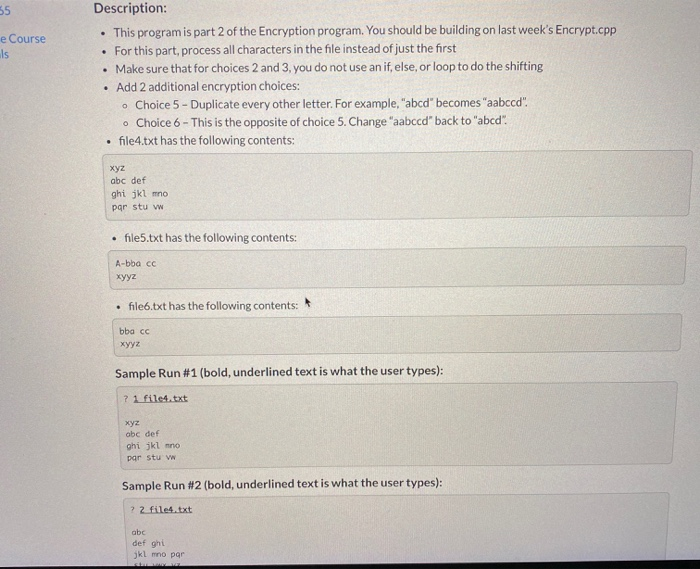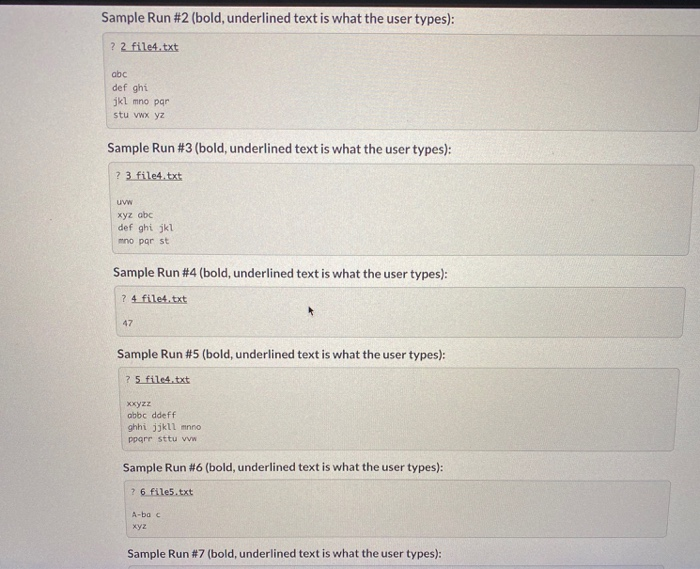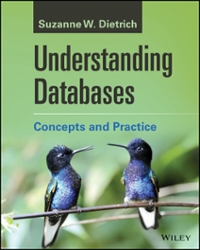e Course Is Description: This program is part 2 of the Encryption program. You should be building on last week's Encrypt.cpp . For this part, process all characters in the file instead of just the first Make sure that for choices 2 and 3, you do not use an if, else, or loop to do the shifting Add 2 additional encryption choices: Choice 5 - Duplicate every other letter. For example, "abcd' becomes aabccd". Choice 6 - This is the opposite of choice 5. Change "aabccd' back to "abcd". file4.txt has the following contents: xyz abc def ghi jk Tr par stu vw file5.txt has the following contents: A-bba cc xyyz file6.txt has the following contents: bba cc ? Sample Run #1 (bold, underlined text is what the user types): 7 1 filet.txt xyz obc def i jkl Tr par stu vw Sample Run #2 (bold, underlined text is what the user types): ? 2 files.txt obc def c klmno por Sample Run #2 (bold, underlined text is what the user types): ? 2 file4.txt abc def ghi jklmno par stu vwx yz Sample Run #3 (bold, underlined text is what the user types): ? 3 file4.txt Uvw xyz abc def ghi jk1 mno par st Sample Run #4 (bold, underlined text is what the user types): ? 4 files.txt 47 Sample Run #5 (bold, underlined text is what the user types): ? 5 file4.txt xxyzz abbc ddeff ghhi jjkll mano ppgrrsttu viw Sample Run #6 (bold, underlined text is what the user types): ? 6 file5.txt A-bac Sample Run #7 (bold, underlined text is what the user types): Sample Run #6 (bold, underlined text is what the user types): 7 6 files.txt A-bac 2 Sample Run #7 (bold, underlined text is what the user types): ? 6 file.txt bac e Course Is Description: This program is part 2 of the Encryption program. You should be building on last week's Encrypt.cpp . For this part, process all characters in the file instead of just the first Make sure that for choices 2 and 3, you do not use an if, else, or loop to do the shifting Add 2 additional encryption choices: Choice 5 - Duplicate every other letter. For example, "abcd' becomes aabccd". Choice 6 - This is the opposite of choice 5. Change "aabccd' back to "abcd". file4.txt has the following contents: xyz abc def ghi jk Tr par stu vw file5.txt has the following contents: A-bba cc xyyz file6.txt has the following contents: bba cc ? Sample Run #1 (bold, underlined text is what the user types): 7 1 filet.txt xyz obc def i jkl Tr par stu vw Sample Run #2 (bold, underlined text is what the user types): ? 2 files.txt obc def c klmno por Sample Run #2 (bold, underlined text is what the user types): ? 2 file4.txt abc def ghi jklmno par stu vwx yz Sample Run #3 (bold, underlined text is what the user types): ? 3 file4.txt Uvw xyz abc def ghi jk1 mno par st Sample Run #4 (bold, underlined text is what the user types): ? 4 files.txt 47 Sample Run #5 (bold, underlined text is what the user types): ? 5 file4.txt xxyzz abbc ddeff ghhi jjkll mano ppgrrsttu viw Sample Run #6 (bold, underlined text is what the user types): ? 6 file5.txt A-bac Sample Run #7 (bold, underlined text is what the user types): Sample Run #6 (bold, underlined text is what the user types): 7 6 files.txt A-bac 2 Sample Run #7 (bold, underlined text is what the user types): ? 6 file.txt bac









